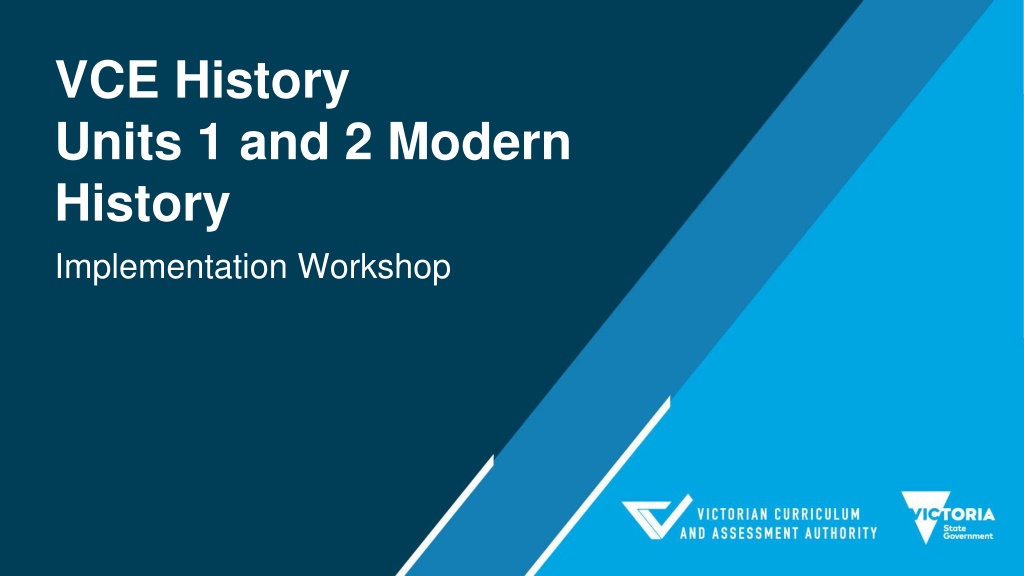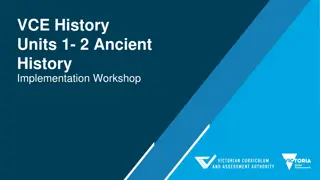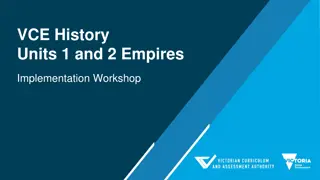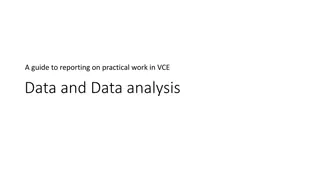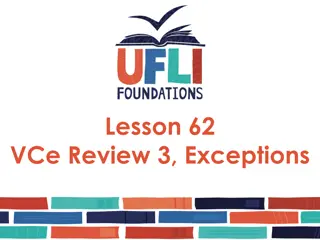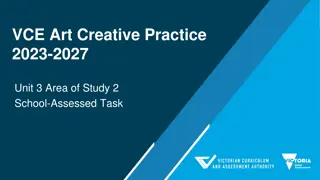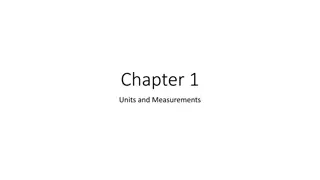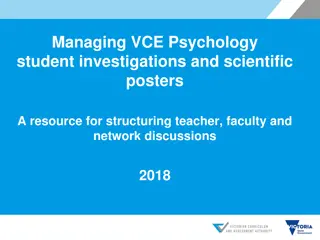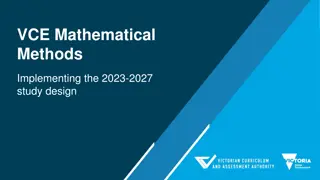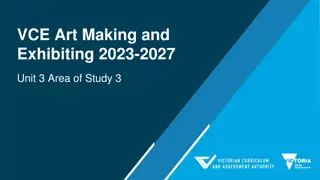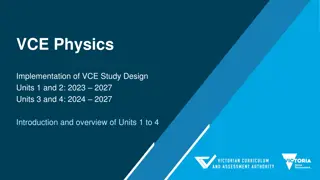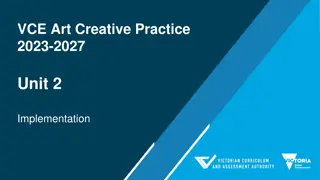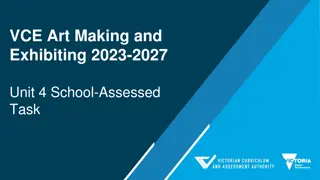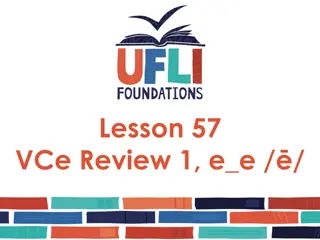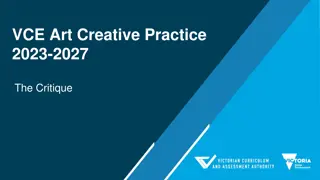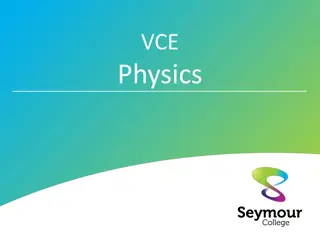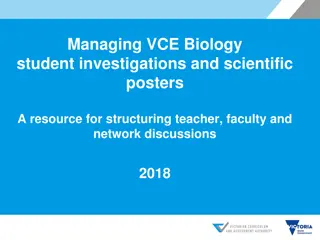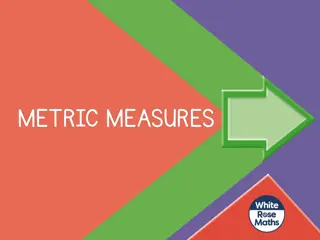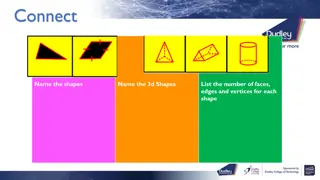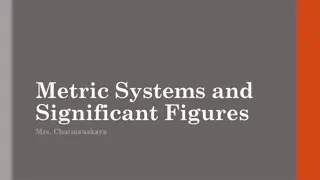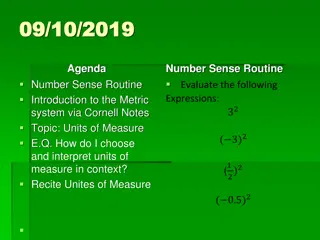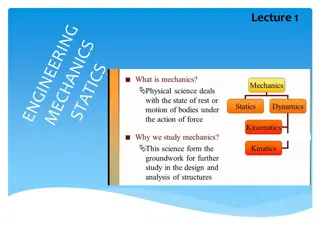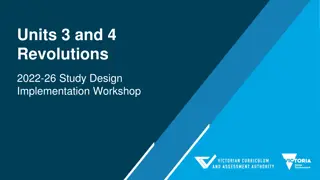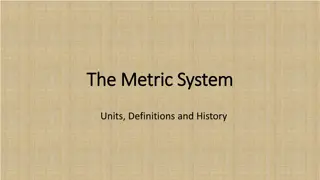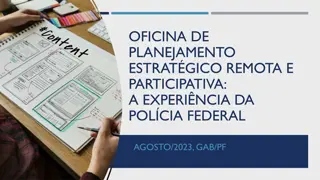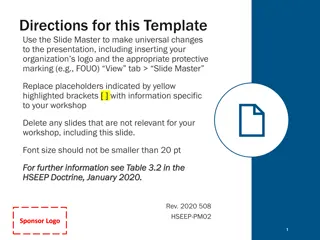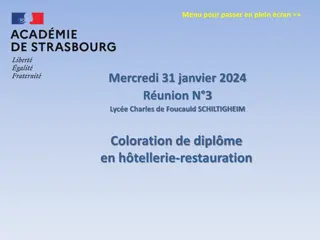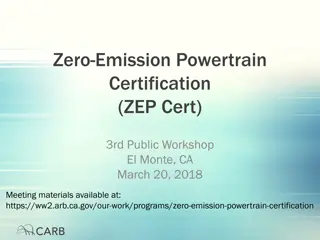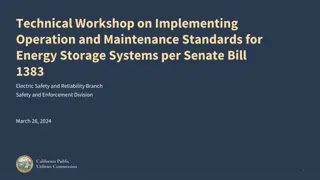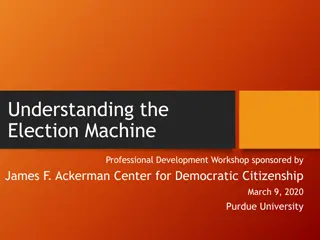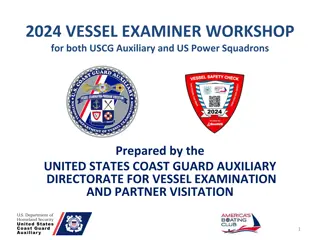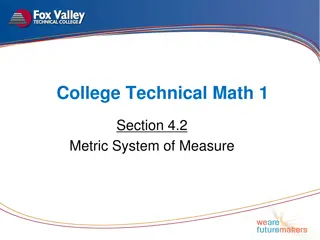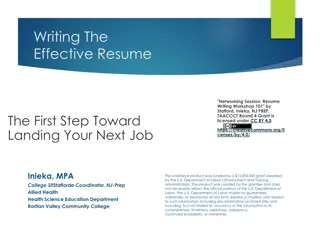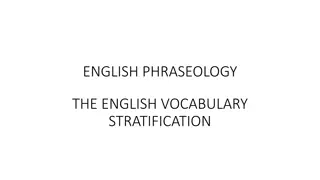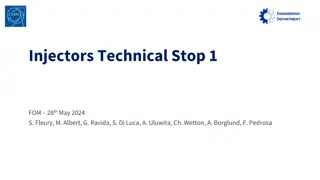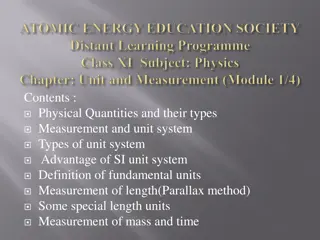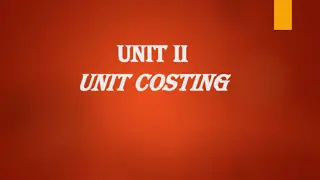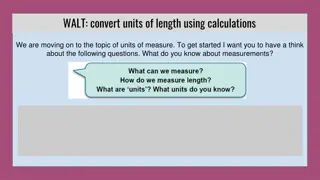VCE History Units 1 and 2 Modern History Workshop Overview
Explore the implementation workshop for VCE History Units 1 and 2 Modern History, including acknowledgment of country, areas of study, changes in the curriculum, and big planning ideas for teaching themes and ideas. The workshop covers key topics such as change and conflict, the Cold War, social and cultural change, and historical thinking concepts.
Download Presentation

Please find below an Image/Link to download the presentation.
The content on the website is provided AS IS for your information and personal use only. It may not be sold, licensed, or shared on other websites without obtaining consent from the author. Download presentation by click this link. If you encounter any issues during the download, it is possible that the publisher has removed the file from their server.
E N D
Presentation Transcript
VCE History Units 1 and 2 Modern History Implementation Workshop
Acknowledgment of Country I would like to acknowledge the traditional custodians of the many lands across Victoria on which each of you are living, learning and working from today. For myself and those of us in the Melbourne metropolitan area, we acknowledge the traditional custodians of the Kulin Nations. When acknowledging country, we recognise Aboriginal and Torres Strait Islander peoples spiritual and cultural connection to country and acknowledge their continued care of the lands and waterways over generations, while celebrating the continuation of a living culture that has a unique role in this region. I would like to pay my respects to Elders past, present and emerging, for they hold the memories, traditions, culture and hopes of all Aboriginal and Torres Strait Islander peoples across the nation, and hope they will walk with us on our journey.
Outline At a glance Features of Units 1 and 2 Modern History Overview of the areas of study Teaching ideas Questions
At a glance Unit 1 Change and conflict Ideology and conflict Unit 2 The changing world order Causes, course and consequences of the Cold War Challenge and change Area of Study 1 Area of Study 2 Social and cultural change
Overview of changes Change of title to Modern History Flexibility in the timeframe to allow of the context selected Made the historical concepts more explicit in outcomes and key knowledge Refined the outcomes
Overview of changes Refined the key knowledge The stems have been refined for clarity and emphasise historical thinking concepts Knowledge has been reorganised to make it more coherent more illustrated examples of knowledge following .,such as that may be applied depending on the contexts selected
Big Planning Ideas What do you want themes/ideas do you want to teach? How can you weave these themes/ideas throughout your course? Student choice: is there an opportunity for you to tailor a course based on student choice? What will be the following unit 3 and 4? Front loading is possible. Reflection: using a routine such as Roses, Thorns (in your practise) and Buds unpack your experience as a senior history teacher. What would you like to retain? What would you like to change? What excites you about this Study Design?
Unit 1 Change and conflict Area of Study One Ideology and conflict Outcome 1 Explain how significant events, ideologies and individuals contributed to political and economic changes in the first half of the 20th century, and analyse how these contributed to the causes of World War Two. How did significant events and ideas contribute to conflict and change? How did individuals and movements challenge existing political and economic conditions? What were the consequences of World War One? How did ideology influence the emergence of new nation states? To what extent did the events, ideologies, individuals, movements and new nations contribute to the causes of World War Two? Inquiry Questions
Unit 1: Change and conflict Area of Study One: Ideology and conflict Changes Reorganisation and clarification of the: - Outcome - Key Knowledge - Key skills
Unit 1: Change and conflict Area of Study One Ideology and conflict Key knowledge an overview of the significant events of the late 19th century and the first half of the 20th century that caused the end of empires and influenced the emergence of nation states, the consequences of World War One, the significant ideologies that strengthened, challenged and/or weakened empires and/or nation states, continuity and changes to political structures and systems of nation states, significant individuals who contributed to political change, the significant causes of World War Two in 1939,
Unit 1: Change and conflict Ideology and conflict Area of Study One Relationship between Key knowledge and Skills ask and use a range of historical questions to explore political and economic change prior to World War Two analyse sources for use as evidence identify the perspectives of people and how perspectives changed over time identify different historical interpretations about political and economic change analyse the consequences of World War One and the causes of World War Two explain how political and economic conditions changed and/or stayed the same evaluate the historical significance of events, ideas, individuals and movements construct arguments about political and economic change using sources as evidence.
Teaching and Learning Ideas Create a political ideologies compass Allocate pairs of students different political cartoons or visuals to identify and analyse to better understand perspectives Create an annotated timeline, colour-coding events into change or continuity of political structures and systems
Teaching and Learning Ideas Develop significance criteria to assess a factor of significance using Think-Pair-Share Comparison of impacts of World War One Asking historical questions- before, during and after
Unit 1: Change and conflict Social and cultural change Explain patterns of social and cultural change in everyday life in the first half of the twentieth century, and analyse the conditions which influenced these changes. Area of Study Two Outcome 2 Inquiry Questions How did society and culture change? How did cultural life both reflect and challenge the prevailing political, economic and social conditions? How did ideologies contribute to continuities and changes in society and culture? What role did individuals, groups and movements play in social and cultural continuity and/or change?
Historical Contexts In this area of study students may focus on one or more of the following contexts: Australia, China, France, Germany, Italy, Japan, Russia/USSR, the Ottoman Empire/Turkey, the British Empire/United Kingdom and/or the USA.
Units 1: Change and conflict Area of Study Two: Social and cultural change Changes Reorganisation and clarification of the: - Outcome-minor edits - Key Knowledge minor edits to emphasise concepts and some additional knowledge examples - Key skills
Units 1: Change and conflict Area of Study Two Social and cultural change Key knowledge the significant changes in how society was organised and the ways this influenced how people lived their lives, continuity and change to the social life and experiences of people, the methods and consequences of inclusion and/or exclusion of certain groups from participating in the society,... the ways in which particular forms of cultural expression such as art, literature, architecture, film and music both influenced and reflected social, economic and political change the reasons for government, group and individual attempts to control, influence or resist cultural expression and use propaganda to challenge, influence and/or change political and social agendas the perspectives and experiences of those affected by social and cultural change, the significance of individuals and/or movements that contributed to social and/or political change through cultural expression,
Units 1: Change and conflict Social and cultural change Area of Study One Relationship between Key knowledge and Skills ask and use a range of historical questions to explore how everyday life changed prior to World War Two analyse sources for use as evidence identify the perspectives of people and how perspectives changed over time identify different historical interpretations about continuities in and changes to everyday life analyse the causes and consequences of changes to everyday life explain how social and cultural conditions changed and/or stayed the same evaluate the significance of events, ideas, individuals and movements that influenced and resisted change construct arguments about social and cultural continuity and change using sources as evidence.
Teaching and Learning Ideas Evaluation of historical value and reliability of a film depicting the context/s selected. Research how technological developments, such as in film and the wireless, changed daily life and enabled the spread of ideas and culture. Examine the unique experiences of a minority group
Unit 2: The changing world order Area of Study One Causes, course and consequences of the Cold War Outcome 1 Explain the causes of the Cold War and analyse its consequences on nations and people. Inquiry Questions What were the causes of the Cold War? How did Cold War ideology contribute to increased tensions and conflict? What were the consequences of the Cold War on nations and peoples? What caused the end of the Cold War? How did the social, political, economic and cultural conditions influence and change the post-Cold War world?
Historical Contexts In this area of study students may focus on one or more of the following contexts: Australia, China, France, Germany, Italy, Japan, Russia/USSR, the Ottoman Empire/Turkey, the British Empire/United Kingdom and/or the USA. Teachers may continue with the same one as Unit One or do a different one
Unit 2: The changing world order Area of Study One:Causes, course and consequences of the Cold War Changes Reorganisation and clarification of the: - Outcome- refined for clarity - Key Knowledge minor edits - Key skills
Key knowledge the causes of the Cold War, the economic, political and social characteristics of the competing ideologies of communism in the USSR, and liberal democracy and capitalism in the USA and Europe the significant features and consequences of the peace conferences at Yalta and Potsdam, the establishment and goals of the UN, the significant features and tensions of the Cold War, proxy wars and conflicts that reflected the consequences of tensions and divisions of the Cold War, focusing on one or more of the following: the Korean War, the causes and reasons for the division of Germany and Berlin, causes of challenge and dissent among Soviet Satellites, the Vietnam War, events in Cuba and/or the civil war in Angola long-term and short-term causes of the end of the Cold War,
Unit 2: The changing world order Causes, course and consequences of the Cold War Area of Study One Relationship between Key Knowledge and Skills ask and use a range of historical questions to explore the causes and consequences of the Cold War analyse sources for use as evidence identify the perspectives of people and how perspectives changed over time identify different historical interpretations about the causes and consequences of the Cold War analyse the causes and consequences of the Cold War explain how social, economic, political and cultural features changed and/or stayed the same during the Cold War evaluate the significance of the Cold War and/or post-Cold War events, ideas, individuals and movements construct arguments about the causes and consequences of the Cold War using sources as evidence.
Teaching and Learning Ideas Create a Radar Chart (also known as a Spider Chart) on the causes of the Cold War Create an annotated timeline Jigsaw routine of the proxy wars and conflicts
Teaching and Learning Ideas Constructing arguments, for example, about the importance of ping-pong diplomacy in the opening up of China, using writing scaffolds such as TEEAL Topic Sentence Explanation Evidence Analysis of evidence Linking sentence
Unit 2: The changing world order Area of Study Two Challenge and change Outcome 2 Explain the challenges to social, political and/or economic structures of power and evaluate the extent to which continuity and change occurred. Inquiry Questions What caused the challenges to existing political and/or social structures and conditions? How did the actions and ideas of popular movements and individuals contribute to continuity and change? To what extent did change occur? What were the perspectives and experiences of those who demanded and/or resisted change?
Unit 2: The changing world order Area of Study Two: Challenge and change Changes Reorganisation and clarification of the: - Outcome- refined for clarity - Key Knowledge refined for clarity and emphasise concepts - Key skills
Historical Contexts This area of study focuses on challenge and change in relation to at least one of the following themes: Decolonisation and self-determination movements, Terrorism campaigns, Regional conflicts, Social and political movements. Study Design p.26 provides suggested examples for each
Units 2: The changing world order Area of Study One Challenge and change the causes, significant events and conditions that challenged traditional social, political and/or economic structures of power the local and global ideas that influenced continuity and/or change, significant individuals, movements and/or groups who challenged existing structures of social, political and/or economic power and contributed to change the methods employed by individuals and/or groups to express their views and demand change, the responses and actions of established social, political and/or economic powers who sought continuity by resisting challenges and changes the extent to which change occurred and goals and ideas were successfully achieved and implemented the perspectives and experiences of those who challenged and demanded change and those who resisted change the short-term and long-term consequences of particular events, ideas and movements. Key knowledge
Units 2: The changing world order Challenge and change Area of Study One Relationship between Key knowledge and Skills ask and use a range of historical questions to explore the challenges and changes to structures of power analyse sources for use as evidence identify the perspectives of people and how perspectives changed over time identify different historical interpretations about challenges and changes to structures of power analyse the causes and consequences of challenges to power structures explain how structures of power changed and/or stayed the same evaluate the significance of events, ideas, individuals and movements construct arguments about continuity and change in modern history.
Teaching and Learning Ideas Create a flowchart that details the short-term and long-term consequences of the actions of the Palestinian Liberation Organisation. Create a global map of the hot-spots of protests during the year 1968. Use arrows to indicate how each protest sparked or influenced another protest. Speak like an expert task: students record themselves, presenting as a historian would, on the perspectives and experiences of those living through the selected context. Story, source, scholarship worksheet.
Assessment Ideas Suitable tasks for assessment in these units may be selected from the following: Examples such as: Creating a website analysing the reliability of relevant primary sources A historical inquiry with a final extended response a historical inquiry an essay evaluation of historical sources short-answer questions extended responses a multimedia presentation.
Creating a website analysing the reliability of relevant primary sources Consider the space the website will be created in Support students to understand copywrite requirements Students should consider for each source the: type, origin, content, context, purpose and reliability In the reliability component students need to make reference to other sources on their website as well as any other relevant factual information and historian/s interpretations
A historical inquiry with a final extended response Consider a framework to follow, such as The Big Six (Eisenberg & Berkowitz 1990) Developing historical inquiry questions can be challenging at the start of a topic, consider scaffolding with guiding big question/s Authentication of student work The extended response (as a part of the synthesis step)
Units 1 and 2 Modern History QUESTIONS
